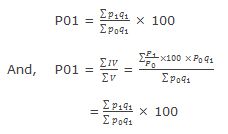Weighted Relative Method
This method is popularly known as the weighted price relative method, or Family budget method. Under this method, index number is computed by the following formula:
P01 = ∑iv/ ∑v, Or ∑pv/ ∑v Or ∑pw/ ∑w
Where, P01 = Price Index of the current year w.r.t. the price of the base year,
I = Index of price, or price relative i.e. (P1/P0) X 100
and P01 = ∑iv/ ∑v
But, where V is taken as equal to P0 × q1, the result obtained by this method using the arithmetic mean equals the result that is obtained under Paasche’s aggregate method. This is because, the two formula equate as under:
Which is Paasche’s formula shown as above.
When geometric mean is used, the above formula of weighted price relatives, and their respective weights.
Merits
- This method commands the following merits:
- It is easy to understand, and simple to calculate.
- It allows the use of both arithmetic and geometric means.
- It allows the construction of different index numbers with a common base in a combined manner.
- It is flexible in the sense in the sense that the old items may be easily replaced by the new ones.
- The price, or quantity relatives of each of the items shown under this method serve themselves as the index numbers.
Demerits
- This method suffers from the following demerits:
- The computations work becomes tedious when geometric mean is used.
- There is no definiteness as to the manner of weighting.
- It does not satisfy the time reversal test and factor reversal test which are most important tests of consistency of a formula of index number.


